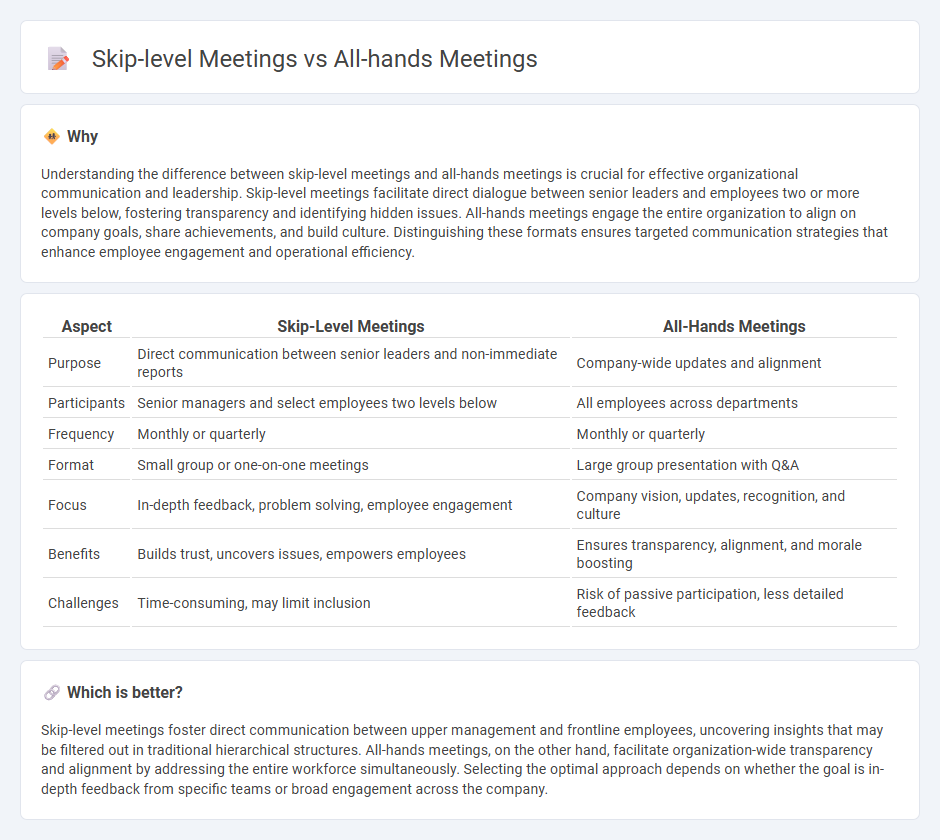
Skip-level meetings foster direct communication between senior leaders and frontline employees, bypassing immediate managers to uncover real-time challenges and opportunities. All-hands meetings engage the entire organization simultaneously, promoting transparency, alignment, and collective morale through shared updates and strategic vision. Explore more to understand how these meeting types can transform organizational communication and effectiveness.
Why it is important
Understanding the difference between skip-level meetings and all-hands meetings is crucial for effective organizational communication and leadership. Skip-level meetings facilitate direct dialogue between senior leaders and employees two or more levels below, fostering transparency and identifying hidden issues. All-hands meetings engage the entire organization to align on company goals, share achievements, and build culture. Distinguishing these formats ensures targeted communication strategies that enhance employee engagement and operational efficiency.
Comparison Table
| Aspect | Skip-Level Meetings | All-Hands Meetings |
|---|---|---|
| Purpose | Direct communication between senior leaders and non-immediate reports | Company-wide updates and alignment |
| Participants | Senior managers and select employees two levels below | All employees across departments |
| Frequency | Monthly or quarterly | Monthly or quarterly |
| Format | Small group or one-on-one meetings | Large group presentation with Q&A |
| Focus | In-depth feedback, problem solving, employee engagement | Company vision, updates, recognition, and culture |
| Benefits | Builds trust, uncovers issues, empowers employees | Ensures transparency, alignment, and morale boosting |
| Challenges | Time-consuming, may limit inclusion | Risk of passive participation, less detailed feedback |
Which is better?
Skip-level meetings foster direct communication between upper management and frontline employees, uncovering insights that may be filtered out in traditional hierarchical structures. All-hands meetings, on the other hand, facilitate organization-wide transparency and alignment by addressing the entire workforce simultaneously. Selecting the optimal approach depends on whether the goal is in-depth feedback from specific teams or broad engagement across the company.
Connection
Skip-level meetings facilitate direct communication between senior management and employees, bypassing immediate supervisors, which provides unfiltered insights into organizational challenges and opportunities. All-hands meetings gather the entire workforce to share company updates, align goals, and reinforce corporate culture. Together, these meetings enhance transparency, foster trust, and drive strategic alignment across all organizational levels.
Key Terms
Communication
All-hands meetings enhance communication by fostering transparency and alignment across the entire organization, enabling leadership to share company-wide updates and strategic priorities directly with all employees. Skip-level meetings focus on communication between senior leaders and employees two levels below, providing a candid channel for feedback and insights that might not surface in regular team interactions. Explore the nuances of these meeting types to improve your organization's communication effectiveness.
Transparency
All-hands meetings promote transparency by fostering open communication between leadership and the entire organization, ensuring that everyone is aligned with company goals and updates. Skip-level meetings enhance transparency by allowing employees to share feedback directly with higher management, bypassing their immediate supervisors and uncovering insights that might otherwise remain hidden. Explore how integrating both meeting types can maximize transparency and strengthen organizational trust.
Hierarchical structure
All-hands meetings engage the entire organization, fostering transparency and alignment across all hierarchical levels. Skip-level meetings promote direct communication between employees and managers two or more levels above, bypassing immediate supervisors to surface insights and concerns often overlooked. Explore how each meeting type strengthens organizational hierarchy and communication dynamics.
Source and External Links
How to Conduct an All Hands Meeting: Best Practices & Tips - An all-hands meeting is a company-wide gathering where employees at every level come together to share updates, celebrate achievements, align on objectives, and boost morale.
What Is an All-Hands Meeting? A Guide to Company-Wide Alignment - These meetings promote alignment on goals, build trust through transparency, celebrate milestones, and encourage engagement with opportunities for questions and feedback.
What's an all-hands meeting? The ultimate guide - All-hands meetings are recurring events that unite everyone in the organization, from management to entry-level staff, to ensure everyone is informed and aligned with company priorities.
 dowidth.com
dowidth.com